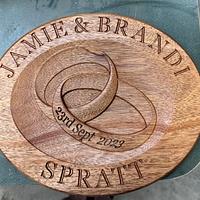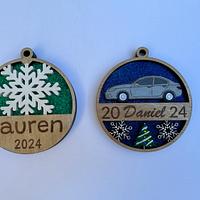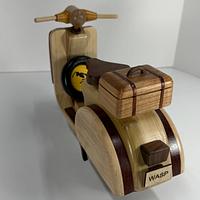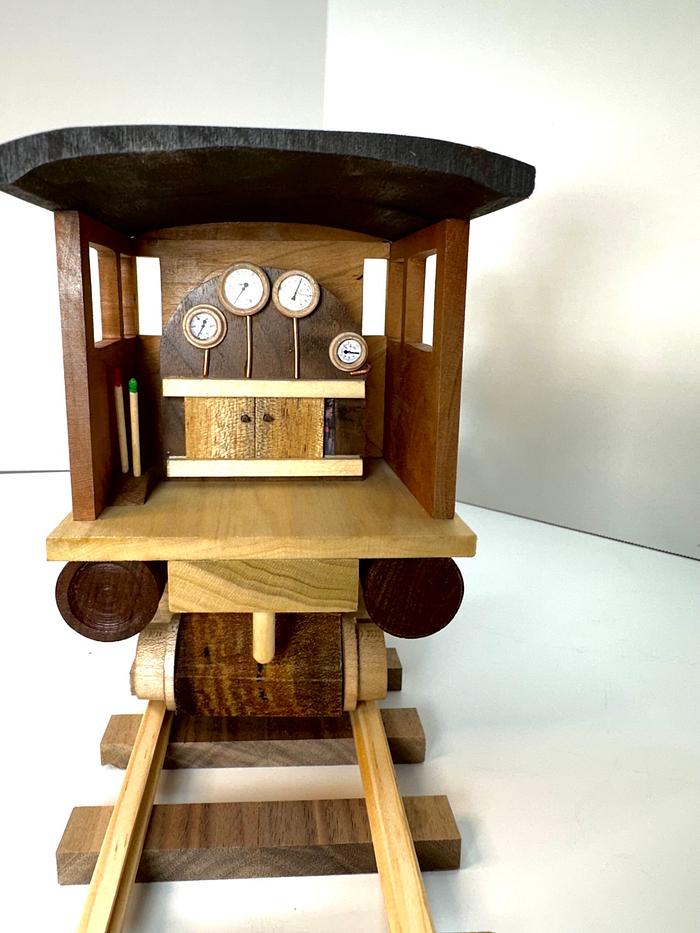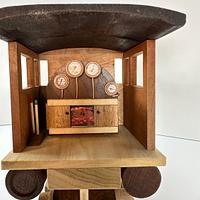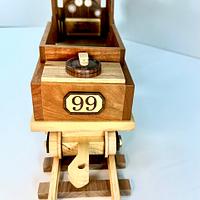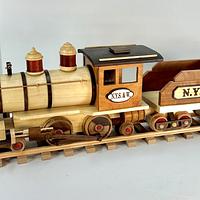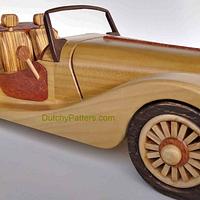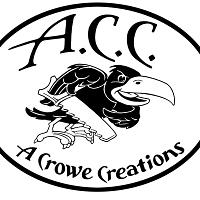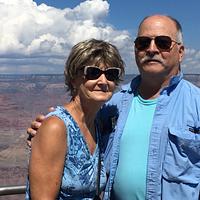Share your craft projects
Make new craft buddies
Ask craft questions
Blog your craft journey

PapaDave
241 posts
and
14 followers
in almost 3 years
in almost 3 years
More from PapaDave
T&J Olde 99 Locomotive
As summer invades the Southern US, I fear my days of shop time is going to be curtailed by other activities and projects so I offer the Olde 99 locomotive as my latest endeavor. It was truly a great build and I had a blast figuring out some of the jigs I would need to complete it. I will also thank those who contributed their insights as to how to drill the holes in the boiler for the rails. Everything, including some of the dowels, are shop built. I will offer that when attaching the drive wheels to the engine, the wheels on the opposite side of the engine should be set at 90 degrees from the opposite side. Doing so will permit the linkage to operate as it should.
This model is built using poplar, walnut, cherry, peruvian walnut, padauk, basswood, purple heart, maple, and a few pieces of "I'm not sure what it is". I did change up the design a bit adding the forward facing windows in the cab, keeping with 19th century locomotive design and I also did not include the "milk can" concept for the water reservoir. Instead, I added a single "manhole cover" type of opening complete with hinge and handle. Now I admit the cover does not open, but then again I do not intend to add water.
The cab interior also took in some refinement and detail not in the original plans. I thought the simple bulk boiler head was just a bit too drab so I turned some dials for the interior and downloaded some period steam locomotive gauge faces to be added to the dials. Copper 12 ga wire was used as the "pipes". I also added the sliding fire doors to the boiler head and added a firebox image. The doors open and closed can be seen in the attached photos.
The side signage are made from 3/16" walnut and 1/16" basswood. I used a laser to engrave the N.Y.S. & W. signs on the cab and tender and the 99 on the back of the tender, as well as making the buttons.
I completed the build by making the track section that it sits on. The materials for the rails is simple pine and the ties are scrap walnut.
Finish for locomotive and tender is a coat of Watco Natural Oil and a couple of coats of MinWax rattle can Satin lacquer.
And finally, before someone asks, NYS&W is the New York Susquehanna & Western railroad chartered in 1832 as the failed New Jersey Hudson & Delaware RR. It is now a CSX owned track.
This model is built using poplar, walnut, cherry, peruvian walnut, padauk, basswood, purple heart, maple, and a few pieces of "I'm not sure what it is". I did change up the design a bit adding the forward facing windows in the cab, keeping with 19th century locomotive design and I also did not include the "milk can" concept for the water reservoir. Instead, I added a single "manhole cover" type of opening complete with hinge and handle. Now I admit the cover does not open, but then again I do not intend to add water.
The cab interior also took in some refinement and detail not in the original plans. I thought the simple bulk boiler head was just a bit too drab so I turned some dials for the interior and downloaded some period steam locomotive gauge faces to be added to the dials. Copper 12 ga wire was used as the "pipes". I also added the sliding fire doors to the boiler head and added a firebox image. The doors open and closed can be seen in the attached photos.
The side signage are made from 3/16" walnut and 1/16" basswood. I used a laser to engrave the N.Y.S. & W. signs on the cab and tender and the 99 on the back of the tender, as well as making the buttons.
I completed the build by making the track section that it sits on. The materials for the rails is simple pine and the ties are scrap walnut.
Finish for locomotive and tender is a coat of Watco Natural Oil and a couple of coats of MinWax rattle can Satin lacquer.
And finally, before someone asks, NYS&W is the New York Susquehanna & Western railroad chartered in 1832 as the failed New Jersey Hudson & Delaware RR. It is now a CSX owned track.
15 Comments
Wow! Another amazing project.
Thanks BB1. It was a lot of fun and every time I build something like this, I learn just how much I still don't know about woodworking, and that's after nearly 55 years. :-)
well done as usual papa. i love when people add embellishments to models like this.
working with my hands is a joy,it gives me a sense of fulfillment,somthing so many seek and so few find.-SAM MALOOF.
It was a lot of fun and every time I build something like this, I learn just how much I still don't know about woodworking, and that's after nearly 55 years. :-)
Well, that's encouraging in a way. These projects are so far outside my current abilities that I cannot even imagine attempting. I guess we all keep learning and that's what makes woodworking so rewarding.
really a well done engine. nice workmanship for sure.
Ron
I get a kick out of the fire doors and burning coal inside 🤠
Details like that and the gauges are what really elevates this!
Fine work as always P_D👍
Details like that and the gauges are what really elevates this!
Fine work as always P_D👍
Thank you all. Part of the joy of doing these builds is providing hopefully some inspiration and design ideas to everyone who sees them.
You did a great job on this one, and can be proud. I like the extra's.
Maybe summertime for you, but soon you want to make a caboose 😉
I myself have also made this one.
What is CSX ? 😜 😜 Feel free NOT to answer.
Maybe summertime for you, but soon you want to make a caboose 😉
I myself have also made this one.
What is CSX ? 😜 😜 Feel free NOT to answer.
Great workmanship.
Thanks, Dutchy. CSX is the corporate entity that used to be the Chesapeake and Ohio RR.
What a beautiful loco, love the extra detailing
Life’s Good, Enjoy Each New Day’s Blessings
all the extra details and the wood choices make this choo choo top notch GR8😍😎👍 JOB
*TONY ** Denver * ALWAYS REMEMBER TO HAVE FUN
Beautifully done! Great detail…
Ryan/// ~sigh~ I blew up another bowl. Moke told me "I made the inside bigger than the outside".
Nice job! The wood choices and details are great.
Dave,
nicely done, the burning coals being behind sliding doors is cool.
nicely done, the burning coals being behind sliding doors is cool.
daveg, SW Washington & AZ









